Significant protection against high-dose simian immunodeficiency virus challenge conferred by a new prime-boost vaccine regimen
- PMID: 21490100
- PMCID: PMC3126289
- DOI: 10.1128/JVI.00342-11
Significant protection against high-dose simian immunodeficiency virus challenge conferred by a new prime-boost vaccine regimen
Abstract
We constructed vaccine vectors based on live recombinant vesicular stomatitis virus (VSV) and a Semliki Forest virus (SFV) replicon (SFVG) that propagates through expression of the VSV glycoprotein (G). These vectors expressing simian immunodeficiency virus (SIV) Gag and Env proteins were used to vaccinate rhesus macaques with a new heterologous prime-boost regimen designed to optimize induction of antibody. Six vaccinated animals and six controls were then given a high-dose mucosal challenge with the diverse SIVsmE660 quasispecies. All control animals became infected and had peak viral RNA loads of 10(6) to 10(8) copies/ml. In contrast, four of the vaccinees showed significant (P = 0.03) apparent sterilizing immunity and no detectable viral loads. Subsequent CD8(+) T cell depletion confirmed the absence of SIV infection in these animals. The two other vaccinees had peak viral loads of 7 × 10(5) and 8 × 10(3) copies/ml, levels below those of all of the controls, and showed undetectable virus loads by day 42 postchallenge. The vaccine regimen induced high-titer prechallenge serum neutralizing antibodies (nAbs) to some cloned SIVsmE660 Env proteins, but antibodies able to neutralize the challenge virus swarm were not detected. The cellular immune responses induced by the vaccine were generally weak and did not correlate with protection. Although the immune correlates of protection are not yet clear, the heterologous VSV/SFVG prime-boost is clearly a potent vaccine regimen for inducing virus nAbs and protection against a heterogeneous viral swarm.
Figures
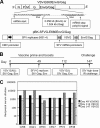
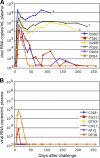

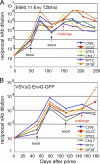
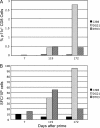
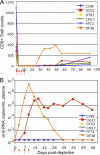
Similar articles
-
Combination Adenovirus and Protein Vaccines Prevent Infection or Reduce Viral Burden after Heterologous Clade C Simian-Human Immunodeficiency Virus Mucosal Challenge.J Virol. 2018 Jan 2;92(2):e01092-17. doi: 10.1128/JVI.01092-17. Print 2018 Jan 15. J Virol. 2018. PMID: 29093095 Free PMC article.
-
Breakthrough of SIV strain smE660 challenge in SIV strain mac239-vaccinated rhesus macaques despite potent autologous neutralizing antibody responses.Proc Natl Acad Sci U S A. 2015 Aug 25;112(34):10780-5. doi: 10.1073/pnas.1509731112. Epub 2015 Aug 10. Proc Natl Acad Sci U S A. 2015. PMID: 26261312 Free PMC article.
-
Transmitted/founder simian immunodeficiency virus envelope sequences in vesicular stomatitis and Semliki forest virus vector immunized rhesus macaques.PLoS One. 2014 Oct 31;9(10):e109678. doi: 10.1371/journal.pone.0109678. eCollection 2014. PLoS One. 2014. PMID: 25360552 Free PMC article.
-
Is an HIV vaccine possible?Braz J Infect Dis. 2009 Aug;13(4):304-10. doi: 10.1590/s1413-86702009000400013. Braz J Infect Dis. 2009. PMID: 20231996 Free PMC article. Review.
-
Good CoP, bad CoP? Interrogating the immune responses to primate lentiviral vaccines.Retrovirology. 2012 Oct 1;9:80. doi: 10.1186/1742-4690-9-80. Retrovirology. 2012. PMID: 23025660 Free PMC article. Review.
Cited by
-
Virus-Like Vesicles Based on Semliki Forest Virus-Containing Rabies Virus Glycoprotein Make a Safe and Efficacious Rabies Vaccine Candidate in a Mouse Model.J Virol. 2021 Sep 27;95(20):e0079021. doi: 10.1128/JVI.00790-21. Epub 2021 Aug 4. J Virol. 2021. PMID: 34346765 Free PMC article.
-
Antigenic requirement for Gag in a vaccine that protects against high-dose mucosal challenge with simian immunodeficiency virus.Virology. 2015 Feb;476:405-412. doi: 10.1016/j.virol.2014.12.027. Epub 2015 Jan 12. Virology. 2015. PMID: 25591175 Free PMC article.
-
Gag and env conserved element CE DNA vaccines elicit broad cytotoxic T cell responses targeting subdominant epitopes of HIV and SIV Able to recognize virus-infected cells in macaques.Hum Vaccin Immunother. 2018;14(9):2163-2177. doi: 10.1080/21645515.2018.1489949. Epub 2018 Jul 12. Hum Vaccin Immunother. 2018. PMID: 29939820 Free PMC article.
-
Balance of cellular and humoral immunity determines the level of protection by HIV vaccines in rhesus macaque models of HIV infection.Proc Natl Acad Sci U S A. 2015 Mar 3;112(9):E992-9. doi: 10.1073/pnas.1423669112. Epub 2015 Feb 13. Proc Natl Acad Sci U S A. 2015. PMID: 25681373 Free PMC article.
-
Development of a hybrid alphavirus-SARS-CoV-2 pseudovirion for rapid quantification of neutralization antibodies and antiviral drugs.Cell Rep Methods. 2022 Mar 28;2(3):100181. doi: 10.1016/j.crmeth.2022.100181. Epub 2022 Feb 24. Cell Rep Methods. 2022. PMID: 35229082 Free PMC article.
References
-
- Barouch D. H., et al. 2002. Eventual AIDS vaccine failure in a rhesus monkey by viral escape from cytotoxic T lymphocytes. Nature 415:335–339 - PubMed
Publication types
MeSH terms
Substances
Grants and funding
LinkOut - more resources
Full Text Sources
Other Literature Sources
Research Materials

